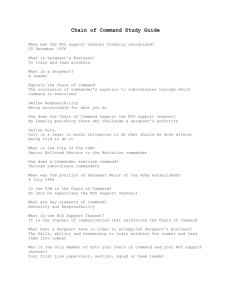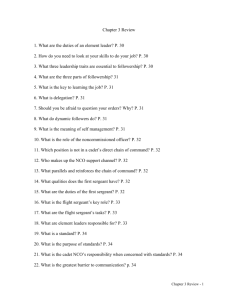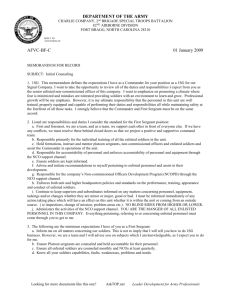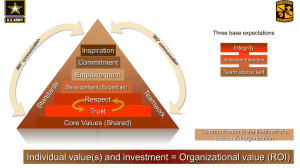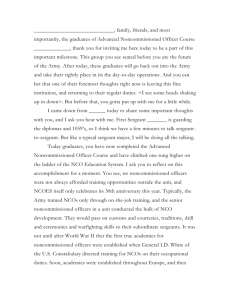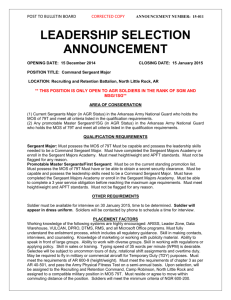Presentation (Powerpoint
advertisement
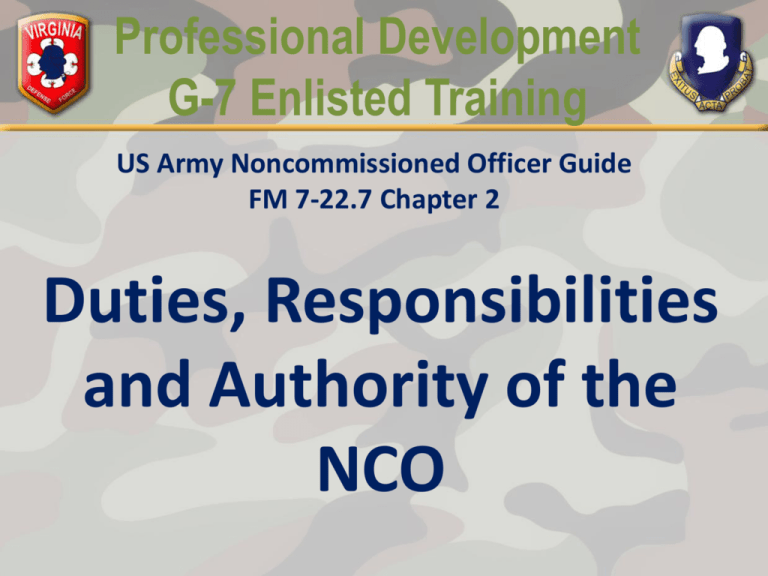
Professional Development G-7 Enlisted Training US Army Noncommissioned Officer Guide FM 7-22.7 Chapter 2 Duties, Responsibilities and Authority of the NCO Introduction As a NCO you have duties, responsibilities and authority. By the end of this class you will know the meaning of duties, responsibilities, and authority. Assuming a leadership position is one of the most important leadership situations you’ll face as an NCO. Duty Something you must do by virtue of your position and is a legal or moral obligation. There are three kinds of duty. Specified Duties Directed Duties Implied Duties Specified Duties are those related to jobs and positions. Directives such as VDF regulations, Department of the Army (DA) general orders, the Uniform Code of Military Justice (UCMJ), soldier’s manuals, VDF Training and Evaluation Program publications and job descriptions specify the duties. Directed Duties are not specified as part of a job position or MOS or other directive. A superior gives them orally or in writing. Directed duties include being in charge of quarters (CQ) or serving as sergeant of the guard, staff duty officer, company training NCO and NBC NCO, where these duties are not found in the unit’s organization charts. Implied duties often support specified duties, but in some cases they may not be related to the MOS job position. These duties may not be written but implied in the instructions. They’re duties that improve the quality of the job and help keep the unit functioning at an optimum level. In most cases, these duties depend on individual initiative. They improve the work environment and motivate soldiers to perform because they want to, not because they have to. For example, while not specifically directed to do so, you hold in-ranks inspections monthly to ensure your soldiers’ appearance and equipment are up to standards. Responsibility Being accountable for what you do or fail to do. There are two types of responsibility. Command Responsibility Individual Responsibility Command Responsibility refers to collective or organizational accountability and includes how well the unit performs their missions. For example, a company commander is responsible for all the tasks and missions assigned to the company; his superiors hold him accountable for completing them. Commanders give military leaders the responsibility for what their sections, units, or organizations do or fail to do. NCOs are therefore responsible to fulfill not only their individual duties, but also to ensure that their team and unit are successful. The amount of responsibility delegated to you depends on your mission, the position you hold and your own willingness to accept responsibility. Professional Development G-7 Enlisted Training "Rank is a badge of responsibility..." Individual responsibility as a noncommissioned officer means you are accountable for your personal conduct. Soldiers in the VDF have their own responsibilities. For example, if you write a check at the commissary, it is your responsibility to have sufficient funds in the bank account to cover the check. Individual responsibility cannot be delegated; it belongs to the soldier that wrote the check. Soldiers are accountable for their actions, to their fellow soldiers, to their leaders, to their unit and to the Virginia Defense Force. As a leader you must ensure that your soldiers understand clearly their responsibilities as members of the team and as representatives of the VDF Authority As a NCO you must know what authority you have and where it comes from. You are also expected to use good judgment when exercising your authority. Authority is defined as the right to direct soldiers to do certain things. Command Authority General Military Authority Delegation of Authority Command Authority is the authority leaders have over soldiers by virtue of rank or assignment. Command authority originates with the Governor and may be supplemented by law or regulation. Even though it is called “command” authority, it is not limited to officers – you have command authority inherent in your leadership position as a 1SG or team leader, for example. Noncommissioned officers’ command authority is inherent with the job by virtue of position to direct or control soldiers. General Military Authority is authority extended to all soldiers to take action and act in the absence of a unit leader or other designated authority. It originates in oaths of office, law, rank structure, traditions and regulations. This broad-based authority also allows leaders to take appropriate corrective actions whenever a member of any armed service, anywhere, commits an act involving a breach of good order or discipline. For example, if you see soldiers in a brawl, you have the general military authority (and the obligation) to stop the fight. This authority applies even if none of the soldiers are in your unit. Delegation of Authority Just as The General Assembly and the Governor cannot participate in every aspect of the armed forces operations, most leaders cannot handle every action directly. To meet the organization’s goals, officers delegate authority to NCOs in the NCO Support Channel who, in turn, may further delegate that authority. Unless restricted by law, regulation, or a superior, leaders may delegate any or all of their authority to their subordinate leaders. However, such delegation must fall within the leader’s scope of authority. Leaders cannot delegate authority they do not have and subordinate leaders may not assume authority that superiors do not have, cannot delegate, or have retained. The task or duty to be performed limits the authority of the leader to whom it is assigned. Inspections and Corrections Why do we have inspections? From experience it has been found that some soldiers, if allowed to, will become carless and lax in the performance of their duties and their personal appearance. Types of Inspections: In-Ranks In-Quarters On-the-Spot Corrections Steps Noncommissioned, Commissioned, and Warrant Officers Relationships General Duties of Commissioned Officers General Duties of Warrant Officers General Duties of Non Commissioned Officers Professional Development G-7 Enlisted Training An important part of your role as an NCO is how you relate to commissioned officers. To develop this working relationship, NCOs and officers must know the similarities of their respective duties and responsibilities. The Commissioned Officer Commands, establishes policy, plans and programs the work of the VDF. Concentrates on collective training, which will enable the unit to accomplish its mission. Is primarily involved with unit operations, training and related activities. Concentrates on unit effectiveness and unit readiness. Pays particular attention to the standards of performance, training and professional development of officers as well as NCOs. Creates conditions – makes the time and other resources available so the NCO can do the Job. Supports the NCO. The Warrant Officer Provides quality advice, counsel and solutions to support the command. Executes policy and manages the Army’s system. Commands special-purpose units and tasksorganized operational elements. Focuses on collective, leader and individual training. Operates, maintains, administers and manages the Army’s equipment, support activities and technical system. Concentrates on unit effectiveness and readiness. Supports the NCO. The Noncommissioned Officer Conducts the daily business of the Army within established orders, directives and policies. Focuses on individual training, which develops the capability to accomplish the mission. Primarily involved with training and leading soldiers and teams. Ensures each subordinate team, NCO and soldier are prepared to function as a effective unit and each team member is well trained, highly motivated, ready and functioning. Concentrates on standards of performance, training and professional development of NCOs and enlisted soldiers. Follows orders of officers and NCOs in the support channel. Gets the job done. The NCO Support Channel The NCO support Channel is subordinate to and Supportive of the chain of command. In units at the battalion level and higher, the NCO support channel is the communication and supervision that begins with the command sergeant major (CSM), and extend through first sergeant and platoon sergeant and ends at the section chiefs, squad leaders, or team leaders. NCO Ranks Command Sergeant Major or Sergeant Major First Sergeant or Master Sergeant Platoon Sergeant or Sergeant First Class Squad, Section and Team Leaders COMMAND SERGEANT MAJOR AND SERGEANT MAJOR The Command Sergeant Major is the senior NCO of the command at battalion or higher levels. The CSM carries out policies and standards on performance, training, appearance and conduct of enlisted personnel. The CSM gives advice and initiates recommendations to the commander and staff in matters pertaining to enlisted personnel. A unit, installation, or higher headquarters CSM directs the activities of that NCO support channel. The support channel functions orally through the CSMs or first sergeant’s call and normally does not involve written instruction. FIRST SERGEANT AND MASTER SERGEANT The First Sergeant is the senior NCO in companies, batteries and troops. The position of first sergeant is similar to that of the CSM in importance, responsibility and prestige. As far back as the Revolutionary War period, first sergeants have enforced discipline, fostered loyalty and commitment in their soldiers, maintained duty rosters and made morning reports to their company commanders. PLATOON SERGEANT AND SERGEANT FIRST CLASS While “Platoon Sergeant” is a duty position, not a rank, the platoon sergeant is the primary assistant and advisor to the platoon leader, with the responsibility of training and caring for soldiers. The platoon sergeant helps the commander to train the platoon leader and in that regard has an enormous effect on how that young officer perceives NCOs for the rest of his career. SQUAD, SECTION AND TEAM LEADERS Staff Sergeants, Sergeants and Corporals are normally squad, section and team leaders and are a critical link in the NCO channel. These NCOs live and work with their soldiers every day and are responsible for their health, welfare and safety. These squad, section and team leaders ensure that their soldiers meet standards in personal appearance and teach them to maintain and account for their individual and unit equipment and property. The NCO enforces standards and develops and trains soldiers daily in skills and unit missions. Professional Development G-7 Enlisted Training Conclusion Are you a Noncommissioned Officer? You as a NCO have a tough, demanding, but very rewarding job. The Soldiers you lead are the heart of the VDF

